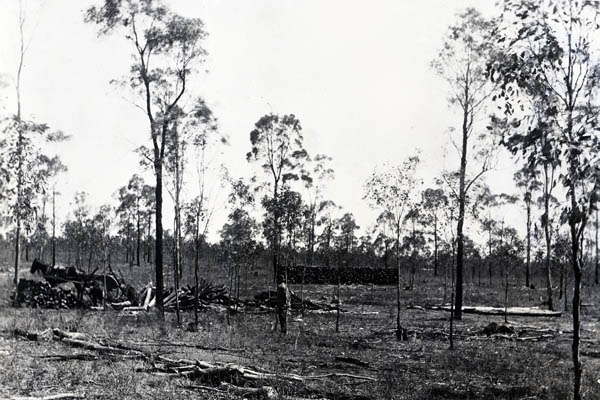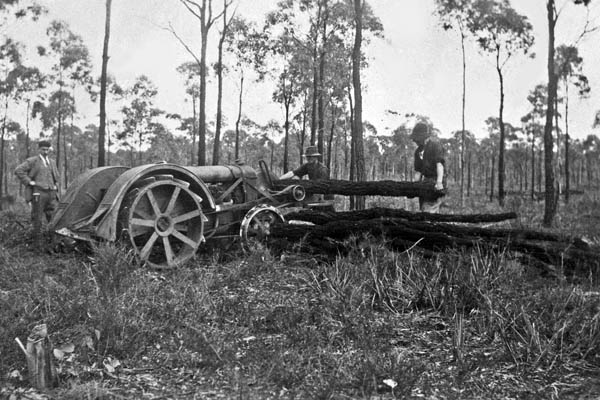Native Forest Improvement - Pre WW2
The scale of early operations conducted to restore the productivity, for timber, of Victoria's badly damaged forest estate was staggering. Extensive areas of forest, and of the box-ironbark forests in particluar, were treated to improve the potential for merchantable growth. The first Annual Report of the FCV comments on the nature of this work.
"The work done in former years in the way of improvement of the natural forest has been steadily continued. During the financial year some 19,400 acres of forest in various stages of growth were treated by gangs of men in the Commission's employment, besides at least 3,000 acres cut over by permit holders under supervision. In the younger forests superfluous seedling or coppice growth is removed, so that the remainder may benefit by the additional light and air and by the extra supplies of plant food of which they are thus enabled to avail themselves. In the older woods stunted, diseased, and crooked trees and saplings are cut out, so that their place may be taken by healthy coppice or seedlings, and so that the standards left remaining may have a chance to develop into useful timber forest. The areas treated under this method up to the present have for the most part consisted of the ironbark and grey box forests in the central portions of the State. These areas, from their proximity to the mining districts, were for years subjected to a heavy drain on their resources for props, firewood, and sleepers, so that the best and largest trees were in many instances practically all removed, only the smaller and less useful remaining." (Source: First Annual Report of the FCV 1919/20)
"During normal seasons, seedling regeneration in the northern box and ironbark forests is sparse, and this condition has been accentuated during the past season owing to weather conditions being adverse. Practically no seedling reproduction has appeared on cut-over or thinned stands. The shortage of rainfall has also had its effect on the growth of coppice regeneration and older trees, although the quantity of coppice regrowth of the principal species has been satisfactory."
"Silvicultural operations in these forests consist principally of reclamation work. The dense coppice regrowth resulting from overcutting during early mining days, has not had sufficient room for normal development, with the result that the majority of the stems are crooked and diseased. Improvement fellings have aimed chiefly at the removal of all useless and diseased growth, and, if necessary, replacing it with fresh coppice shoots. At the same time it is possible to so regulate the thinning that the most desirable species, viz. : red ironbark (E. sideroxylon), and grey box (E. hemiphloia) are favoured against less valuable species. Coppice shoots not required for restocking purposes are later removed in order to lessen root competition for moisture. A ready fuel market for produce removed in the course of such improvement fellings is available, and coppice leaves are in demand for eucalyptus oil distillation." (Source: FCV Annual Report 1929/30)
The FCV Annual Reports from 1935/36 and 1939/40 provide summaries of the areas treated covering the period 1932/33 to 1939/40. If we extract the areas for first thinning, second or subsequent thinning, regeneration or liberation by ringbarking and removal of surplus coppice then we find the areas treated (ha) were:
1932/33 - 61200
1933/34 - 42000
1934/35 - 48600
1935/36 - 80500
1936/37 - 85100
1937/38 -62500
1938/39 - 29800
1939/40 -24800
The decline, particularly from 1939/40 onwards was to allow "maximum concentration on intensive fire protection measures."
The levels of firewood production from these operations would have been considerable, as would the production of fencing materials.
What was the harvesting history of these forests?
"In their virgin state the box-ironbark/gum types consisted of fairly open stands of comparatively large trees. It appears that the stocking was not more than a dozen trees per acre which averaged 30-36 inches DBH. The diameters of the largest trees measured 4-5 feet."
"Thus by the turn of the century exploitation in some degree had extended throughout the box-ironbark forests and on quite extensive areas no less than three crops had been harvested to supply the needs of the mining industry."
Source: The Box-Ironbark Forests of Victoria, Australia. LA Newman 1962. FCV Bulletin No. 14.

Box -ironbark forest after improvement works involving thinning, removal of excess coppice and the production of firewood and other minor produce. Location Unknown.
Probably 1930s
Source: FCRPA

Box -ironbark forest after improvement works involving thinning, removal of excess coppice and the production of firewood and other minor produce. Location Unknown.
Probably 1930s
Source: FCRPA

Red ironbark forest after improvement works involving thinning, removal of excess coppice and the production of firewood and other minor produce. Location Unknown.
Probably 1930s
Source: FCRPA
